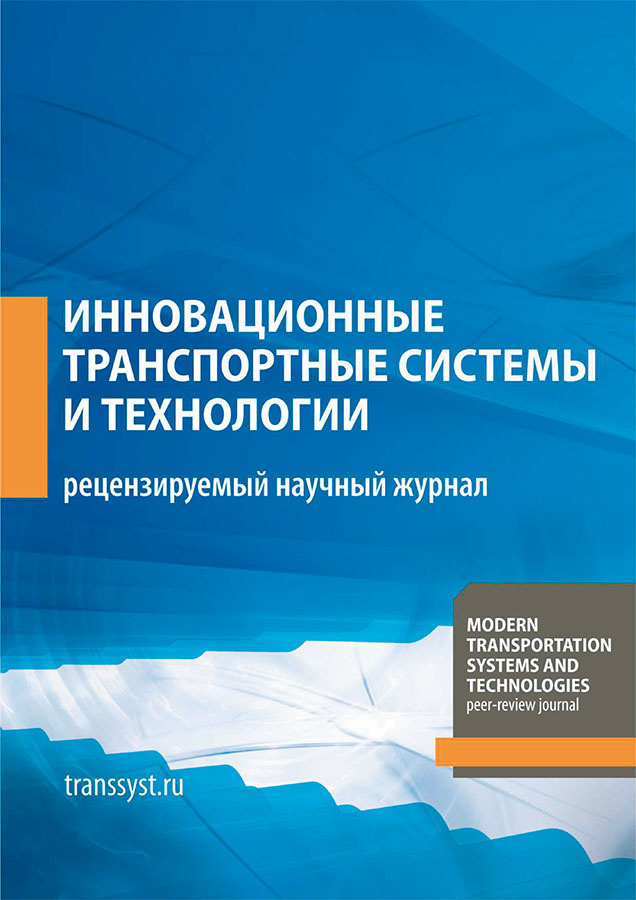Application of taxonomic analysis in assessing the operational strategy of a span structure
- Authors: Ogurtsov G.L.1, Ermoshin N.A.1, Ismailov A.M.1
-
Affiliations:
- Peter the Great St. Petersburg Polytechnic University
- Issue: Vol 11, No 3 (2025)
- Pages: 396-408
- Section: Original studies
- URL: https://journal-vniispk.ru/transj/article/view/328151
- DOI: https://doi.org/10.17816/transsyst684014
- ID: 328151
Cite item
Full Text
Abstract
Aim. Develop a method for comparative analysis of a representative sample of variants of superstructure operation strategies based on a set of heterogeneous features characterizing their reliability and efficiency, as well as to determine the optimal combination of technical and technological solutions to ensure the established design service life.
Materials and methods. One of the main technical and economic indicators when choosing a superstructure operation strategy for bridge structures is the cost of repair and restoration work to achieve the required values of reliability indicators. The choice of rational measures for the operation of bridge superstructures should be based on the use of methods that consider both the diversity and heterogeneity of the factors ensuring their operational reliability, and the stochastic nature of these factors. To solve this problem, a method for assessing the strategy for ensuring the operational reliability of reinforced concrete bridge superstructures is proposed, based on a combination of taxonomic, investment analysis and risk theory methods.
Results. An analytical model has been obtained that allows determining the optimal strategy for the operation of a superstructure based on heterogeneous features characterizing reliability and efficiency, in which the establishment of quantitative reliability indicators is carried out using simulation modeling of the superstructure operation, taking into account the combined effect of uncertainties caused by the natural variability of the strength and deformation parameters of the main beams, the stochastic nature of degradation processes and loading modes.
Conclusion. The presented method for assessing the strategy for operating span structures, as well as the results obtained during its testing, allow operating road construction organizations to determine the required technical and technological solutions to ensure the reliability indicators of span structures, as well as to predict the timing, composition and cost of repair and restoration work during the required service life.
Full Text
##article.viewOnOriginalSite##About the authors
G. L. Ogurtsov
Peter the Great St. Petersburg Polytechnic University
Email: gleb_l_og@mail.ru
ORCID iD: 0000-0002-5183-7420
SPIN-code: 1150-8781
assistant
Russian Federation, St. PetersburgN. A. Ermoshin
Peter the Great St. Petersburg Polytechnic University
Email: ermonata@mail.ru
ORCID iD: 0000-0002-0367-5375
SPIN-code: 6694-8297
Dr. Sci. (Military), professor
Russian Federation, St. PetersburgA. M. Ismailov
Peter the Great St. Petersburg Polytechnic University
Author for correspondence.
Email: ismailov-aleksei@mail.ru
ORCID iD: 0000-0001-9325-2335
SPIN-code: 1929-1225
Cand. Sci. (Engineering), associate professor
Russian Federation, St. PetersburgReferences
- Melehin VB, Magdiev ASh. Methodological foundations for assessing the quality of construction products. Bulletin of Eurasian Science. 2014;4(23):114. (In Russ) EDN: TCFNOB
- Spiridonov ES, Dukhovny GS, Logvinenko AA, et al. Scientific approaches to assessing the quality of products for the construction of transport facilities. Bulletin of the Belgorod State Technological University named after V.G. Shukhov. 2009;2:113–116. (In Russ.) EDN: KWCYKL
- Makhutov NA, Reznikov DO. Comprehensive analysis of the strength and safety of potentially hazardous facilities subject to uncertainties. Dependability. 2020;20(1):47–56. (In Russ.) doi: 10.21683/1729-2646-2020-20-1-47-56 EDN: BZBQMC
- Kartopoltsev VМ, Kartopoltsev AV, Alekseev AA. Towards reliability of load-bearing beams of bridges (Tomsk). Vestnik Tomskogo gosudarstvennogo arkhitekturno-stroitel'nogo universiteta. JOURNAL of Construction and Architecture. 2023;25(6):183–195. (In Russ.) doi: 10.31675/1607-1859-2023-25-6-183-195 EDN: XACQYX
- Kosheleva ZhV, Mikhalevich NV. Calculation of the reliability of a reinforced concrete span bridge during operation. Effective building structures: theory and practice. 2021:71–75. (In Russ.)
- Akhmedov ShB, Almenov H, Shozhalilov ShSh, et al. Assessment of the service life of superstructure structures when predicting the durability of reinforced concrete bridges. Scientific Journal of Transport Vehicles and Roads. 2021;1(4):6–8. (In Russ.)
- Morozova LN, Parkhomenko VV. Determination of the durability of reinforced concrete road bridges. News of the Automobile and Road Institute. 2022;1(40):41–45. (In Russ.) EDN: OVJDYN
- Akhmedov RM, Makhmudov O. Methods of planning and management of bridge repairs. Economy and Society. 2021;11-1(90):774–788. (In Russ.) EDN: QVNNIG
- Ogurtsov GL, Ermoshin NA, Biryukov OR. The algorithm of the simulation model implementation and the simulation results. The Siberian Transport University Bulletin. 2025;(73):104–113. (In Russ.). doi: 10.52170/1815-9265_2025_73_104
- Li CQ, Ian Mackie R, Lawanwisut W. A risk-cost optimized maintenance strategy for corrosion-affected concrete structures. Computer-Aided Civil and Infrastructure Engineering. 2007;5(22):335–346. doi: 10.1111/j.1467-8667.2007.00490.x
- Artyukhov AA. Analysis of the activities of the administration of the Leninsky district of the city of Yekaterinburg on the improvement of the territory. GOSREG: State regulation of public relations. 2022;2(40):120–126. (In Russ.) EDN: KXYXUX
- Gulitskaya LV, Shimanskaya OS. Actual problems of operation of reinforced concrete slab bridge structures. In: XI Forum of Universities of Engineering and Technology Profile of the Union State: collection of materials, Minsk, December 12-16, 2022 / Belarusian National Technical University. Minsk: BNTU. 2023:108–110. (In Russ.) EDN: ENNCUY
- Gulai AV, Zaitsev VM. Synthesis of a taxonomic scheme for identifying the states of complex systems. Artificial Intelligence and Decision Making. 2019;2:84–90. (In Russ.) doi: 10.14357/20718594190208 EDN: ZXFVCJ
- Akhrorov ShAU, Ovchinnikov II. Increasing the durability of reinforced concrete bridge structures (primary and secondary protection). Bulletin of Eurasian Science. 2022.3(14):21. (In Russ.) EDN: CSWOIQ
- Bastidas-Arteaga E, Schoefs F, Chateauneuf A, et al. Probabilistic evaluation of the sustainability of maintenance strategies for RC structures exposed to chloride ingress. International Journal of Engineering Under Uncertainty: Hazards, Assessment and Mitigation. 2010;1-2(2):61–74.
- Bastidas-Arteaga E. Contribution for sustainable management of reinforced concrete structures subject to chloride penetration [dissertation] Nantes; 2010.
Supplementary files









